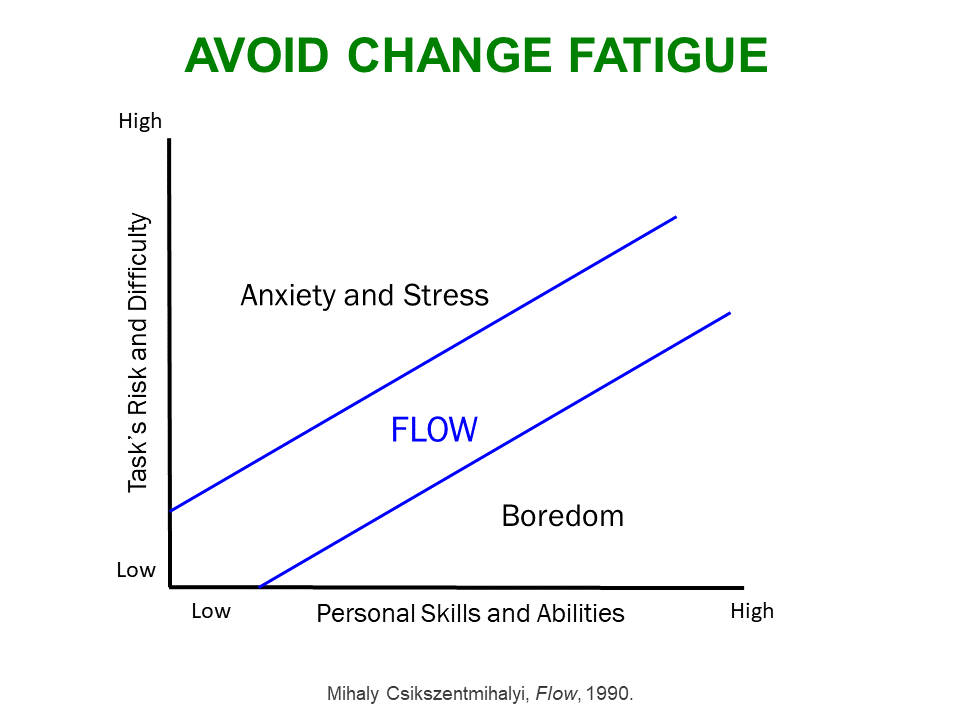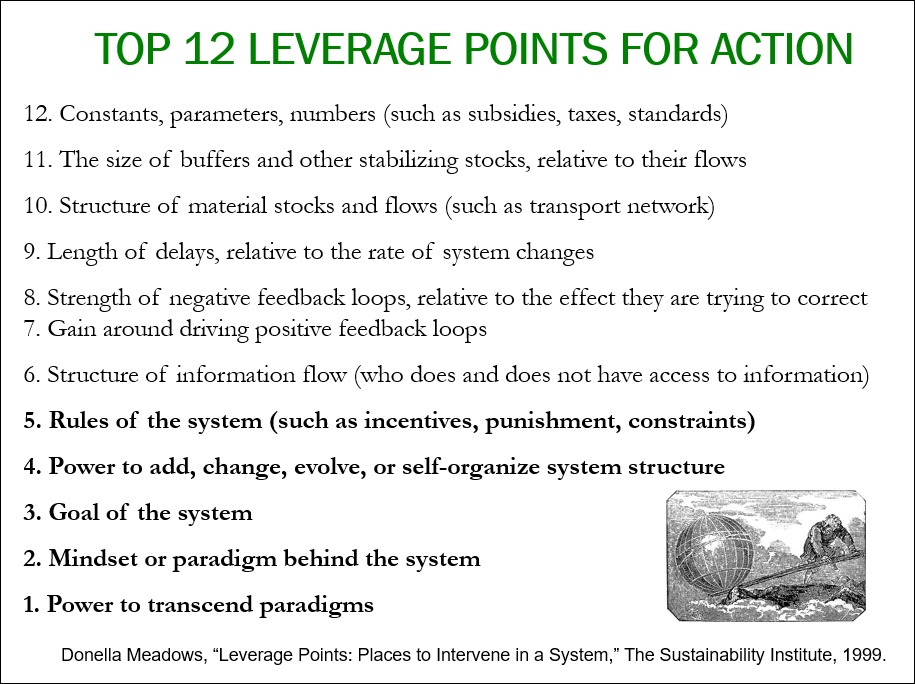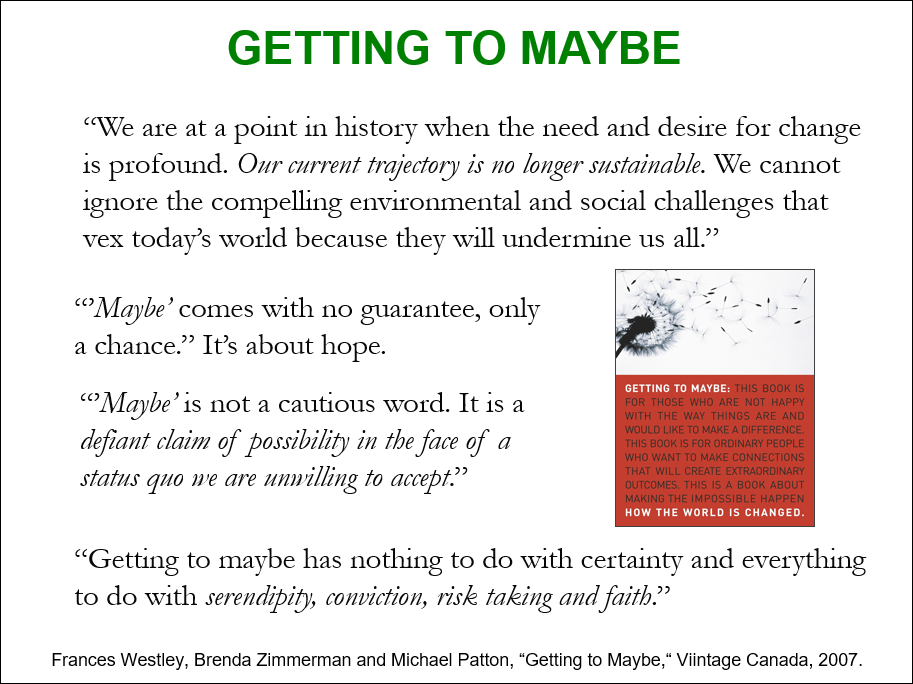Are Three Enoughs Enough? Part 3: Making enough difference
Sustainability champions want to make a difference. We want to create a new paradigm of responsible businesses helping to create a just and resilient human society on a finite, healthy planet. How do we stay upbeat when we fear that we are not making enough difference to accomplish our lofty goals, quickly enough? Let’s look at three dimensions of the answer.
-
Leverage points vs. busy work
We’re all busy, but it’s better to work smart than hard. Smart sustainability champions are busy working on the right things. We focus on optimum leverage points in the target system. We find clever trim tabs that would trigger a new direction for the system that we want to change.
Donella Meadows’ brilliant paper identifies a portfolio of 12 intervention points in complex systems. Here are brief explanations of the top five, through a sustainability champion’s lens.
- Change the rules of the system: Change government and economic regulations, incentives and punishments to require companies to do no harm and even improve the wellbeing of the environment and society-at-large, as well as the economy. Requiring companies to at least disclose how they manage social and environmental challenges is a good beginning, as signaled by the EU Non-Financial Reporting Directive.
- Power to add, change, evolve, or self-organize system structure: Protect the legitimacy of diverse business models and enlightened business purposes ‒ such as embodied by co-operatives, B Corps, and non-governmental organizations ‒ and the evolution of more just socioeconomic systems in which they are immersed.
- Change the goals of the system: Change the goal / purpose of socioeconomic systems to improve the wellbeing and resilience of all, rather than the wealth of a few. For example, at a corporate level, change the purpose of the company from “maximize shareholder wealth” to “maximize stakeholder wellbeing” and legitimize the environment and society-at-large as stakeholders.
- Change the mindset or paradigm out of which the system arises: Point out the failures of current paradigms and their flawed assumptions (e.g. trickle-down economics works, deregulation is good, taxes are bad). For example, Kate Raworth’s recent, clever rap video questions economists’ narrow paradigm of the fundamental nature of humankind.
- Retain the power to transcend paradigms: This one is humbling. This requires us to acknowledge that no paradigm is perfect, even the one we advocate. The way things could / should work in any complex human system is way too complex to be adequately captured in any single paradigm. We need to stay open to better ones.
If we don’t have the power or influence to affect the leverage points directly, we can work through others to make the most difference in the system that we want to change. We can influence the influencers. Usually that’s enough and a smarter way to pull the desired lever.
“Getting to Maybe” is one of the most hopeful and empowering leadership books I’ve read. It reminds us that making the impossible happen in complex human systems is an iffy business. Factors are in play over which we have no control, thank goodness. “It turns out that the timing is right, the moment has come, not through planning, not through rational goal setting, not through careful management and forceful control, but by being at the right place at the right time: a historical moment made conscious and intentional (not simply accidental of serendipitous) by the prepared mind. Intentionality joins possibility joins historical forces.”
We need to be ready to capitalize on the timing, as well as expect the goal posts to shift. And that’s okay. “Maybe” is liberating. Just “getting to maybe” and creating possibilities is enough.
-
Flow vs. burn-out
In his book, Flow, Mihály Csíkszentmihályi described the state of mind we enjoy when performing an activity in which we are fully immersed. We are in the zone. We are energized by having the capacity to accomplish the task. It’s like selecting Sudoku puzzles with the appropriate level of difficulty, or not joining duplicate bridge clubs until we are ready. In essence, flow is characterized by complete absorption in the activity and feeling that we are up to the task.
For sustainability champions, occasional moments of flow recharge our batteries. We don’t feel overwhelmed by the enormity of our endeavors. We doing our best to work on the most influential leverage points in the system and it feels like it’s working. We cut ourselves some slack, do what we can, and carve out roles for ourselves that enable us to grow and take on bigger projects while staying in the band of flow depicted in the figure. If we haven’t experienced a state of flow recently, we’re probably trying to do too much rather than enough. Life’s too short to burn ourselves out for the cause. Besides, burnt out crusaders are not good role models when recruiting others to the effort.
So how much difference-making is enough? If we are smart about directly or indirectly influencing leverage points, if we get to “maybe” and if we strive for a state of flow in our efforts, that’s enough.
This is the third blog in the three-part “enough” series. Part 1 explored what enough wealth looks like. Part 2 delved into how we would recognize enough sustainability if we ever found it. Part 3, this one, examines how we can reassure ourselves that we are making enough difference, The three “enoughs” are interconnected aspects of a sustainability champion’s healthy mindset. When present, doing enough is fun.
Enough?
Bob
Please feel free to add your comments and questions using the “Leave a reply” comment box under the “Share this entry” social media symbols, below. For email subscribers, please click here to visit my site and provide feedback. Slides shown will be included in my next quarterly release of Latest Workbook & Slides, to which anyone can subscribe.






Comments are closed.